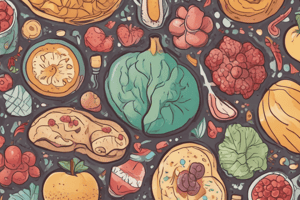Podcast
Questions and Answers
What is the primary function of macronutrients?
What is the primary function of macronutrients?
- Providing energy and building blocks for growth and maintenance (correct)
- Regulation of bodily functions
- Supporting immune system function
- Maintaining nerve function
Which of the following is a characteristic of micronutrients?
Which of the following is a characteristic of micronutrients?
- Required in large amounts
- Provide energy for bodily functions
- Essential for various bodily functions, but required in smaller amounts (correct)
- Not essential for human health
What is the primary function of proteins in nutrient metabolism?
What is the primary function of proteins in nutrient metabolism?
- Supporting growth and development (correct)
- Regulating bodily functions
- Supporting immune system function
- Providing energy for bodily functions
Which of the following factors influences nutrient requirements?
Which of the following factors influences nutrient requirements?
What is the purpose of feed trials in feed evaluation?
What is the purpose of feed trials in feed evaluation?
What is the term for a disorder related to nutrient metabolism?
What is the term for a disorder related to nutrient metabolism?
Which type of digestive system is characterized by a multi-chambered stomach?
Which type of digestive system is characterized by a multi-chambered stomach?
What is the term for the measure of how well an animal can absorb and utilize nutrients from feed?
What is the term for the measure of how well an animal can absorb and utilize nutrients from feed?
Flashcards are hidden until you start studying
Study Notes
Nutrient Classification
- Macronutrients: provide energy and building blocks for growth and maintenance
- Carbohydrates (sugars, starches, and fibers)
- Proteins (amino acids)
- Fats (fatty acids)
- Micronutrients: essential for various bodily functions, but required in smaller amounts
- Vitamins (A, D, E, K, and B vitamins)
- Minerals (Ca, P, Na, K, etc.)
Nutrient Functions
- Energy metabolism: carbohydrates, fats, and proteins provide energy for bodily functions
- Growth and development: proteins, carbohydrates, and fats support growth and development
- Maintenance: vitamins and minerals support various bodily functions (e.g., immune system, nerve function)
Nutrient Requirements
- Species-specific: different species have unique nutritional requirements
- Life stage-specific: different life stages (e.g., growth, reproduction, lactation) have different nutritional requirements
- ** Environmental factors**: climate, altitude, and other environmental factors can influence nutritional requirements
Digestive Systems
- Monogastric: single-chambered stomach (e.g., humans, pigs, chickens)
- Ruminant: multi-chambered stomach (e.g., cows, sheep, goats)
- Pseudoruminant: intermediate between monogastric and ruminant (e.g., horses, rabbits)
Feed Evaluation
- Nutrient analysis: chemical analysis of feed to determine nutrient content
- Feed trials: feeding animals a specific diet to evaluate its nutritional value
- Nutrient bioavailability: measure of how well an animal can absorb and utilize nutrients from feed
Nutrition-related Disorders
- Deficiencies: lack of essential nutrients (e.g., vitamin D deficiency, protein deficiency)
- Toxicities: excessive intake of certain nutrients (e.g., vitamin A toxicity, selenium toxicity)
- Metabolic disorders: disorders related to nutrient metabolism (e.g., ketosis, acidosis)
Nutrient Classification
- Macronutrients provide energy and building blocks for growth and maintenance, comprising carbohydrates, proteins, and fats
- Carbohydrates include sugars, starches, and fibers
- Proteins are composed of amino acids
- Fats are made up of fatty acids
- Micronutrients, including vitamins and minerals, are essential for various bodily functions but required in smaller amounts
- Vitamins include A, D, E, K, and B vitamins
- Minerals include calcium, phosphorus, sodium, potassium, and others
Nutrient Functions
- Carbohydrates, fats, and proteins provide energy for bodily functions
- Proteins, carbohydrates, and fats support growth and development
- Vitamins and minerals support various bodily functions, such as immune system and nerve function
Nutrient Requirements
- Nutrient requirements vary across species and are unique to each species
- Different life stages, such as growth, reproduction, and lactation, have distinct nutritional requirements
- Environmental factors, including climate, altitude, and others, can influence nutritional requirements
Digestive Systems
- Monogastric animals, such as humans, pigs, and chickens, have a single-chambered stomach
- Ruminant animals, such as cows, sheep, and goats, have a multi-chambered stomach
- Pseudoruminant animals, such as horses and rabbits, have an intermediate digestive system
Feed Evaluation
- Nutrient analysis involves chemical analysis of feed to determine nutrient content
- Feed trials involve feeding animals a specific diet to evaluate its nutritional value
- Nutrient bioavailability measures how well an animal can absorb and utilize nutrients from feed
Nutrition-related Disorders
- Deficiencies occur when essential nutrients are lacking, such as vitamin D deficiency or protein deficiency
- Toxicities occur when certain nutrients are consumed in excess, such as vitamin A toxicity or selenium toxicity
- Metabolic disorders, such as ketosis and acidosis, are related to nutrient metabolism
Studying That Suits You
Use AI to generate personalized quizzes and flashcards to suit your learning preferences.



